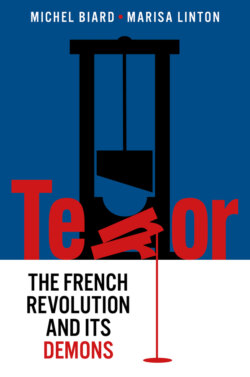Terror

Реклама. ООО «ЛитРес», ИНН: 7719571260.
Оглавление
Michel Biard. Terror
CONTENTS
List of Illustrations
Guide
Pages
Terror. The French Revolution and Its Demons
Dedication
Note on the Text
Acknowledgements
Foreword
Introduction: The Demons of Terror
Notes
Chapter 1 The Terror – a Concept Imposed by the Thermidorians
1. How the ‘system of terror’ and the black legend of Robespierre were retrospectively invented
2. Developing use of the word ‘terror’ between 1789 and 1794
3. ‘Terror as the order of the day’: an unsaid, unofficial yet widespread order from the Convention
Notes
Chapter 2 The Meaning of ‘Terror’ Before the Revolution
1. Terrorand Enlightenment. A problematic connection
2. The concept of ‘terror’ in the Ancien Régime
3. The role of terror in political theory
Notes
Chapter 3 Terror in the Heart: The Weight of Fears and Emotions
1. The spectre of conspiracy and treason
2. The flow of emotions and fears
3. The impossible combination of virtue and terror
Notes
Chapter 4 The Revolution and its Opponents: Clashes and the Intensification of Repression
1. Legislation targeting refractory clergy andémigrés
2. ‘The suspects’: how the net of suspicion widened
3. Repression against ‘federalism’ and the emblematic case of the Lyon revolt
Notes
Chapter 5 Creating Revolutionary Law: A Time of Political Exception
1. From ordinary law to ‘revolutionary’ law
2. ‘Revolutionary’ institutions and their role in repression
3. The recourse to extraordinary justice
Notes
Chapter 6 Terror in the Convention: Political Conflict as an Engine of ‘Terror’
1. The Convention and the clubs: from political strife to ‘purging’
2. From arrests to political trials
3. Death as a means to eliminate opponents in the Convention
4. The elimination of factions, the apogee of ‘terror’ or the will to end it?
Notes
Chapter 7 Paris and the Vendée at the Heart of the ‘Terror’
1. Paris, capital of thesans-culottemovement
2. Paris, epicentre of the ‘Terror’
3. The ‘military Vendée’, a zone of civil war
Notes
Chapter 8 Who Lived and Who Died? The Difficult Balance Sheets of Terror
1. Working out the death toll
2. Fraternal France and fratricidal France
Notes
Conclusion: How the Convention Reconstructed Itself After Thermidor
Notes
Chronology for the Years of the National Convention
Maps
Some Further Reading
Index. A
B
C
D
E
F
G
H
I
J
K
L
M
N
O
P
Q
R
S
T
V
W
POLITY END USER LICENSE AGREEMENT
Отрывок из книги
Michel Biard and Marisa Linton
With a Foreword by Timothy Tackett
.....
In the autumn of 1792, a letter in the newspaper Le Moniteur reported how French troops entered Belgium after the victory at Jemappes (6 November): ‘Dumouriez is at the gates of Brussels. Terror precedes the republic’s victorious armies. The despots and their cowardly servants are on the run.’28 In the first months of the Vendée uprising in 1793 (on the Vendée, see chapter 7), ‘terror’ was often used in its military, not political, meaning, as in a terror inflicted by soldiers, as two news items in Le Moniteur on 2 July show. The first, a dispatch from the northern front, related that ‘the French victory near Arlon had truly instilled terror in the area, so much so that the boat masters of Trier had received an order to keep their boats nearby in order to transport the warehouses further away.’29 The second item, a letter from General Westermann, announced that ‘the terrible example of Amailloux and the castle of Lescure sowed terror among the lost inhabitants’. Amailloux was a town in which Westermann’s troops hunted down the Vendéen rebels, burning down buildings and killing a number of inhabitants while the general proclaimed that any village providing aid or recruits to the rebels would suffer the same fate. That same day, he burnt down the castle of Clisson, residence to Lescure, one of the Vendéen leaders. This recourse to terror did not, in itself, seem to raise any doubt, considering that the convergence of these two events, on different military fronts, one exterior, the other interior, shows that the military meaning of the term was well accepted. On the other hand, the fact that the example Westermann wished to give affected not only the armed rebels but also civilians testifies to the horrors of a local civil war. This military meaning of ‘terror’, furthermore, never stopped being operative, with numerous examples available from debates in the Convention and published writings in the press. On 16 Messidor Year II (4 July 1794) for example, about three weeks before 9 Thermidor and in the middle of the month with the greatest number of executions by guillotine in Paris, Barère used ‘terror’ in a military sense, not a political one, even if he was careful to employ the fashionable political rhetoric of the time on the notion of the ‘order of the day’:
Terror and flight were the order of the day for the odious hordes. The French troops cannot follow the flight of the imperial eagle, and the lands of Belgium are not so wide, and lack enough strongholds, to protect or hide the flight of the confederates … Ostend was the barbarous warehouse of the royal coalition, the overflowing granary of the armies, the most complete arsenal of tyrants, and the infernal support of the London court, which will also be taught to know terror, just like its satellites make its deadly experience … Terror and discouragement reign today among the slaves.30
.....